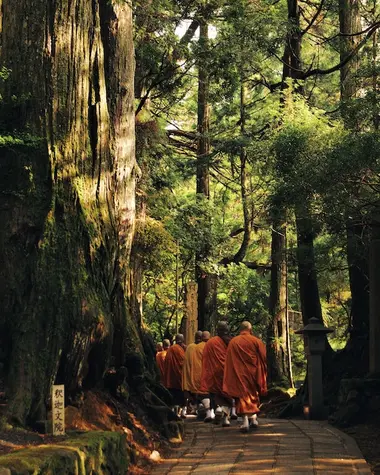Spiritual Immersion
Spiritual journey to the land of Zen
The place of religions in Japan
The Japanese people are recognized for their calm and restraint around the world, which they derive from concepts derived from Buddhism and Shintoism applied for centuries. From religion to martial arts, through flower arranging and pilgrimages, a brief overview of Japanese spirituality.
Most Japanese participate in both Shinto and Buddhist rituals throughout their lives, without considering themselves religious, just as many Westerners celebrate Christian holidays by tradition.
In Japan, belonging to a religion rather refers to sectarian organizations and movements derived from the two main religions, with which 90% of Japanese people do not wish to be associated. The same person can go to the Shinto shrine before an exam, for example, buy a charm there and pray, but also have a Buddhist altar at home and go to the temple regularly.
Traditional weddings are increasingly being replaced by Western-inspired ceremonies in chapels.
- To read : Differences between temples and shrines

Le temple Kennin-ji à Kyoto
© Randall Meng, Unsplash
Many traditions from Shintoism and Buddhism are rooted in Japanese mores , and are thus practiced without the notion of belief in one or more gods being invoked. Everyone goes without distinction to the Shinto matsuri and honors their deceased according to Buddhist rites.
Other religions are also represented, even if greatly in the minority compared to Shintoism derived from very ancient Japanese beliefs and Buddhism imported from China and Korea around 1,500 years ago.
Christianity was introduced in the 16th century to Kyushu, but it was only a few decades before persecutions began and missionaries were expelled from the country. Religion is then simply banned and Japan enters its period of autarky for more than 200 years. With more than 500,000 Christians on the archipelago , you can come across many buildings such as churches, basilicas and cathedrals. Learn about the history of Japan's hidden Christians after Christianity was banned at the museum dedicated to them in Nagasaki .
- Read also: Oura Church, the oldest in Japan
More and more expatriates and tourists from South Asia and the Middle East are pushing Japan to adapt to the practices of the Muslim religion . Even though there are fewer than 100 mosques in the archipelago, more and more establishments are adapting by offering prayer mats and Halal menus.
- Read also: Being a Muslim in Japan
You will be able to practice your own spirituality while discovering that of the country of the Rising Sun.
To find oneself or find oneself in spirituality
Japanese beliefs from Shintoism and Buddhism are very focused on respect for nature and others, on prayers to deities and inspire a philosophy of life rather than imposing rules. Meditation, prayers and ceremonies invite reflection and openness of mind. Many concepts have emerged from these religious practices and it is through Buddhist Zen that they have been transmitted over the centuries.
- Read also: Zen
Among them, ikigai is about finding what gives meaning to our lives and drives us to get up every morning. Thus, it is the search for our ikigai that allows us to flourish and learn more about ourselves. Another concept derived from Zen, wabi-sabi invites us to appreciate the simplicity and imperfection of things.
Japanese spirituality is also found in arts such as ikebana (flower arrangement), bonsai , the tea ceremony but also in poetry and painting , not forgetting in martial arts . We obviously find there the notions of balance, calm, respect, patience and perseverance . The practice of these arts brings inner peace and personal fulfillment .
Immerse yourself in spirituality across the archipelago
During your trip, you will have many opportunities to immerse yourself in Japanese spirituality as closely as possible .
- Spend the night in a temple to experience the daily life of Buddhist monks and meditate with them in accordance with Zen practices. Read the article
- Take part in a tea ceremony and discover the subtlety of this highly codified art. Read the article
- Make one of the many pilgrimages to visit the country's most sacred sites. Read the article
- Climb the slopes of Mount Fuji to enjoy the sunrise at the top of Japan. Read the article
- Admire the balance and aesthetics of the dry gardens with their raked gravels. Read the article
- Pray at a shrine and hang a plaque with your wish at the temple.
Read the article

